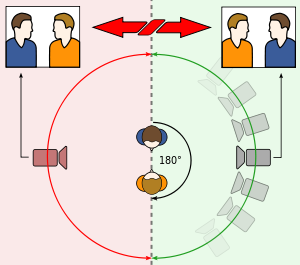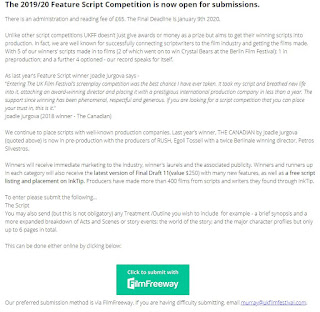The Development and Principles of Editing
This is a clip from The Impossible, this shows the emotional scene where a family are reunited after a treacherous journey which befell them after a tsunami.
Editing Analysis
Gradually throughout the video, the shots and cuts start of longer and gradually get shorter building up tension due to its quickness to emphasize that it is not slowing down. A simple cut transition is mainly used in this clip.
Firstly, we see the mother looking towards something behind the camera, a motivated edit, which then cuts to the shadow of what we assume to be the son behind a curtain. The son hesitates to leave, but finally does and there is a long pause onto the mother to create empathy towards her character. Parallel editing enforces the on-edge feeling as all of the family are near the same hospital making the viewer anxious and hoping that they will reunite, this is amplified by the fact that they can be viewed on the same shot transitioning (where the camera's focus switches to each character) from the parallel Ashot at 0:24 where the dad was walking and the son was getting water for his mother. Next, there is a motivated shot of Lucas' eyes widening, the audience assumes he sees his father as a point of view shot is used where all you can see is the fathers legs. The action shots become longer and more drawn-out which makes the viewer feel on-edge, connecting with the child's emotions and how long it seems when he is searching for his father, it finally stops for a moment when the boy reaches the ledge and looks beyond the thousands of people. A wide bird's eye view of the hospital is added after to re-establish that they are in the same area, but also to add to the 'needle in a haystack' doubt. Parallel used throughout to build tension, seeing as they are so close to each other.
Phantom tracking is applied from 1:55 to help the audience understand the overwhelming feeling Lucas must be feeling, his lost hope and desperation coming out through the camera. This is re-enforced when the camera does a 360 spin around Lucas to create his uneasy and panicked feeling. A shot reverse shot and a zoom in to emphasise the realisation of him finding his brothers, this can sometimes make the audience have 'shivers along their back', close-ups are used a lot in the initial reunion scene to show the characters facial expressions which creates an emotional impact on the viewer, even watching it without sound can create an impact just by seeing the editing. A motivated edit is next where Lucas sees his dad, keeping the 180 degree rule, there is a shot reverse shot at reunion with eyeline-match shots. Quicker cuts and more shots are added at the reunion up until it gradually gets slower as the brothers and father reunite with the mother again and the shots are longer which creates a release of tension.
SPLICING:
Splicing is when you physically cut out words, lines, scenes or sounds you do not want and then adding the remaining pieces back together again with adhesive (splice) tape to create a film you would like to see. This straightforward technique was used on film and is done usually by a splicing machine.
DIGITAL EDITING/IN-CAMERA EDITING:
Instead of editing after the filming is over, in-camera editing is when the director or cinematographer shoots in a strict order and the edit is therefore complete when the film is developed. This is used for time-efficiency.

LINEAR EDITING/NON-LINEAR EDITING:
This is when footage is transferred onto a computer then edited using a specific software such as Premiere Pro. It is very flexible and allows the video to be mixed up and changed easily.
CONTINUITY:
180 DEGREE RULE- is a guideline where two characters in a scene should be at the same sides (left/right) at all time to not confuse the viewer.
SHOT REVERSE-SHOT- is a technique where one character is shown looking at another character who is off screen and then the second character is shown.
This allows the viewer to assume they are looking at one another. Depending on their facial expressions it can create tension, happiness or sadness.
MATCH CUT ON ACTION, EYE-LINE MATCH CUT- where one shot cuts to anther shot portraying the same action. Helps keep the continuity and a 'visual bridge' which draws an audiences attention.
CUTAWAY- Is an interruption of a continuously flowing film by adding in a second scene about something else, it can also be followed by a shot of the scene before the cutaway.
JUMP CUT- Is where two different shots of the same subject are taken from different positions that vary only slightly like a tiny fraction if at all.
TRANSITIONS:
WIPE- Where a shot replaces itself with another by traveling across from side to side or into the screen. There are many different types of wipe however it is not used in film that often.
FADE- Is where in post-production a shot gradually turns to a single colour such as black or white. Fade Ins are usually at the start of a film and fade outs are usually at the end of a film.
DISSOLVE- A dissolve is like a fade but it fades with the next shot so it gradually changes the picture.
CUT- A cut is very common and the most basic. It is where the film goes through no special transition and just changes the image on screen abruptly.
SCREEN TIME, SHOT TYPES / DISTANCE

Through different film-making techniques we are able to tell who the main characters are. These techniques are screen time, shot types and distances. Screen time means that you are able to see the character grow and develop showing more emotion and integrity. Shot types such as close-ups or mediums shots show the distance of protagonists and how we are able to get reactions from them. They are seen more often and usually well light to see their faces and expressions rather than a villains who are usually hidden by shadows to keep an air of mystery.
Sound Editing Analysis
Dramatic classical music enhances the tension and on-edge feeling to it, and as Lucas spots his dad the music speeds up creating making the viewer become more drawn in by the action, then suddenly it slows down again as the two brothers arrive. Lucas' breathing is amplified as the crowd becomes louder as he is panicked due to the fact he cannot find his dad, just before he spins around trying to find his dad, the music reaches its peak. As soon as the brothers reunite, there is a happier tone of music as they run towards one another, and it rises again as the father finds them again. Gradually becoming even louder now just before Lucas says to his dad "mum is here" and the music suddenly stops, putting emphasis on it and telling the viewer that this the most important part and/or information. No music is played when the whole family is together again with their mother because the editors want the viewers to know this is real and to hear the emotions in the characters voices is more important than the music.


Comments
Post a Comment